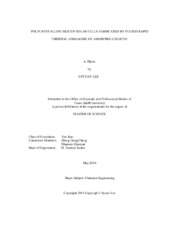| dc.description.abstract | The PECVD intrinsic, n^(+), and p^(+) a-Si:H thin film deposition processes have been studied by the optical emission spectroscope to monitor the plasma phase chemistry.
Process parameters, such as the plasma power, pressure, and gas flow rate, were correlated to SiH*, H_(a), and H_(β) optical intensities. The power, pressure, and hydrogen
dilution effect on radical intensities and intensities ratio such as H_(a)/SiH* and H_(β)/H_(a) were investigated. For all films, the deposition rate increases with the rise
of the SiH* intensity. For the doped films, the H_(α)/SiH* ratio is a critical factor affecting the resistivity. Changes of the free radicals intensities can be used to explain
variation of film characteristics under different deposition conditions. The n^(+) and p^(+) layer were optimized by analyzing the optical emission spectra.
The i-layer was optimized by assembling it with n^(+) and p^(+) to a PIN diode and measuring the current-voltage characterization under solar light illumination.
H_(a)*/SiH* ratio is an important clue to study the effects of H content and Si-H binding mode on solar light conversion efficiency. The moderate hydrogenation can
improve the film quality by passivating the dangling bonds, which acts like recombination centers in the film. However, too much H content leads to the increasing amount of
SiH_(2) in the film, which causes the dangling bonds and deteriorates the film. The pattern size and the thickness of light-absorbed layer (i-layer) were also optimized.
The novel nickel-induced crystallization with low thermal budget was demonstrated. Polycrystalline silicon thin films were formed from the amorphous silicon thin films by
the pulsed rapid thermal annealing process enhanced with a thin nickel seed layer through the vertical crystallization mechanism. The crystalline volume fraction, grain size,
and the material properties of polycrystalline i-, n^(+), and p^(+) silicon layers were reported. The influence of PRTA frequency and the dopant effect were also investigated.
It has been demonstrated that a 30 nm thick amorphous silicon could be transformed into polycrystalline with 70%-80% of crystalline volume fraction in a short time.
The thin-film polycrystalline silicon solar cells were produced using nickel-induced crystallization with amorphous silicon film and a thin Ni layer. The conversion efficiency
was improved by transforming amorphous n^(+) to polycrystalline n^(+). The n^(+)/i- and i-/p^(+) interfaces trapped Ni atoms and deteriorated the diode property after
crystallizing the films on the top of n^(+). The current-voltage characterizations in the dark, under red, green, blue, and solar light illumination were measured and investigated. | en |


